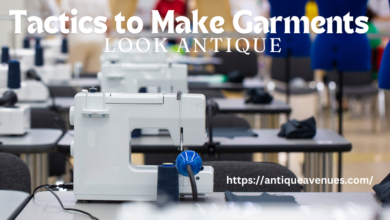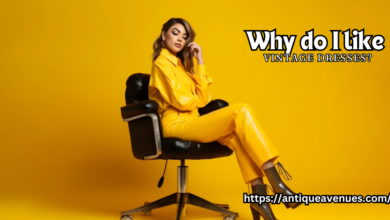Why is vintage clothing so popular now?

Vintage clothes have shifted from niche finds at charity shops to essential pieces for modern fashion in recent years. This rise in popularity is indicative of a societal shift in which customers place higher value on quality, individuality, and ecological responsibility than on the fads of quick fashion. Old fashion has grown to be a significant movement, with Generation Z customers wanting original secondhand goods and celebrities wearing old designer clothing. This article examines the primary causes of this phenomenon, looking at the place of social media in the resurgence of vintage clothes, as well as economic, cultural, and environmental factors.
Sustainability and Environmental Awareness

The Impact of Fast Fashion
It is becoming hard to ignore the negative aspects of fast fashion. The sector produces 10% of the globe’s carbon emissions, which is greater than the total emissions from international travel and maritime shipping. The synthetic variety of textiles takes hundreds of years to break down in garbage dumps when 92 million tons of textile waste are dumped annually. Fast fashion is founded on exploitative labor practices, which subject low-paid workers in developing nations to dangerous conditions of employment.
Vintage clothes have emerged as a clear solution due to these realities, which have forced clients toward more environmentally friendly options. Vintage shopping lessens the need for new production by increasing the life of already-existing clothing, reducing environmental damage.
The Rise of Slow Fashion
The slow fashion trend, which values quality and durability above mass production, is a great fit for antique apparel. The cheaply manufactured items of fast fashion and antique clothing were usually crafted with superb workmanship, causing them to last for decades.
Vintage selling sites like ThredUp and Depop are at the forefront of the circular fashion economy, which is a system in which clothing is repaired, reused, and recycled. The younger generation and Gen Z in particular are driving this change, with 62% of their peers selecting used fashion over fresh goods.
Unique Style and Individuality
Rejection of Mass-Produced Fashion
In a time when fast fashion retailers produce identical styles, vintage fashion offers unique pieces that let wearers stand out. It usually features extensive details, distinctive fabrics, and silhouettes that aren’t found in modern garments.
A different significant variable is nostalgia. The techniques from the 1970s disco, the 1950s pin-ups, and the years following grunge all make an appearance in modern fashion cycles. The fashion community can represent these eras in a manner that current replicas cannot by wearing true vintage.
Influence of Celebrities and Fashion Icons
Celebrities have greatly helped popularize vintage clothes. The singer Harry Styles likes pants with flares and eye-catching patterns from the 1970s, while Bella Hadid usually uses vintage Chanel and 90s slip dresses. Stars like the pop singer and the singer have dazzled on red carpets wearing antique designer clothing, demonstrating that old fashion can be just as glitzy as the latest.
Luxury businesses are also tapping the trend. The latest runway fashion embraces the past, as shown in Gucci’s retro-inspired collections and Prada’s reissued classic designs. In the meantime, more people can now afford luxury vintages thanks to websites like the Vestiaire Group and The RealReal.
Economic Factors and Affordability
Rising Costs of New Clothing
The price of goods rises due to inflation, so many people look to vintage as an economical choice. A well-made antique clothing and coat can last longer and cost less than its fast-fashion counterpart.
The responses from the previous design team may also be investments. The Chanel name coats from the 1980s and Fendi outfits from the 1990s are a few exceptional finds that are highly prized and sought after by collectors.
Growth of Secondhand Marketplaces
The rise of online thrifting has revolutionized vintage shopping. Platforms like Depop, Etsy, and eBay allow users to buy and sell vintage globally, while apps like Grailed cater to high-end streetwear collectors.
The local vintage boutiques and thrift stores are also thriving, providing specialized customers with carefully chosen items. The fashionable search for the exclusive is drawn to events like Paris’ Marché aux Puces and the city’s Portobello Market.
Cultural and Social Media Influence

The Role of Social Media
TikTok and Instagram have spurred the vintage boom. These individuals promote environmentally conscious clothing options, and hashtags like #VintageFashion and #ThriftFlip highlight creative styling concepts.
DIY upcycling instructions also pique interest, and YouTube thrift haul videos show viewers how to upcycle old items into contemporary standout pieces.
Vintage as a Form of Self-Expression
The users of vintage clothing can create a distinctive character. The vintage clothes allow people to express their distinct personalities, trends, and the independent 80s aesthetic of punk and the romantic 70s feelings of the cottage core style.
This connects to the anti-consumerism movement when younger generations choose deliberate, leisurely buying to the exploitative tactics of rapid fashion.
The Future of Vintage Fashion
Continued Growth of Resale Markets
In 2027, it is projected that the secondhand market will have doubled, with streetwear and premium vintage driving the expansion.
Technological Innovations
These days, blockchain confirms the origin of clothing, counterfeits, and apps powered by AI vintage items.
Challenges Ahead
As demand grows, rising prices threaten to make vintages less accessible. Additionally, fast fashion brands copying vintage styles risk diluting their authenticity.
Conclusion
The low prices, distinctiveness, sustainability, and social significance of vintage clothing are the main factors contributing to its appeal. Customers reject fast fashion due to its wastefulness, but vintage offers a stylish, moral alternative. The glass is to social media and resale marketplaces. Retro fashion is a phenomenon that will impact how people dress in the future, rather than merely being a passing trend. When we accept vintage, we honor the fashion industry’s development while producing a more artistic and nutritious selection for the future.




